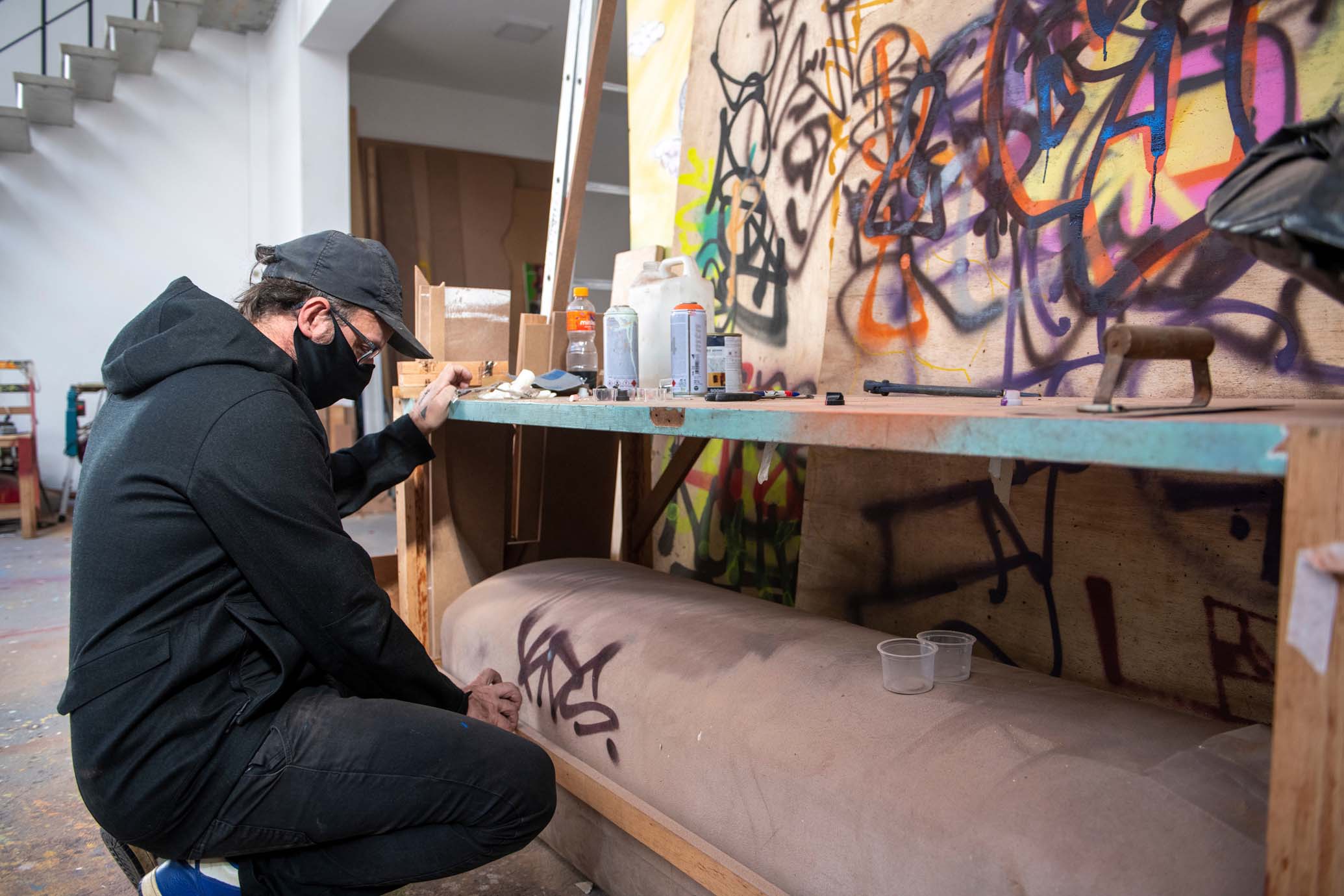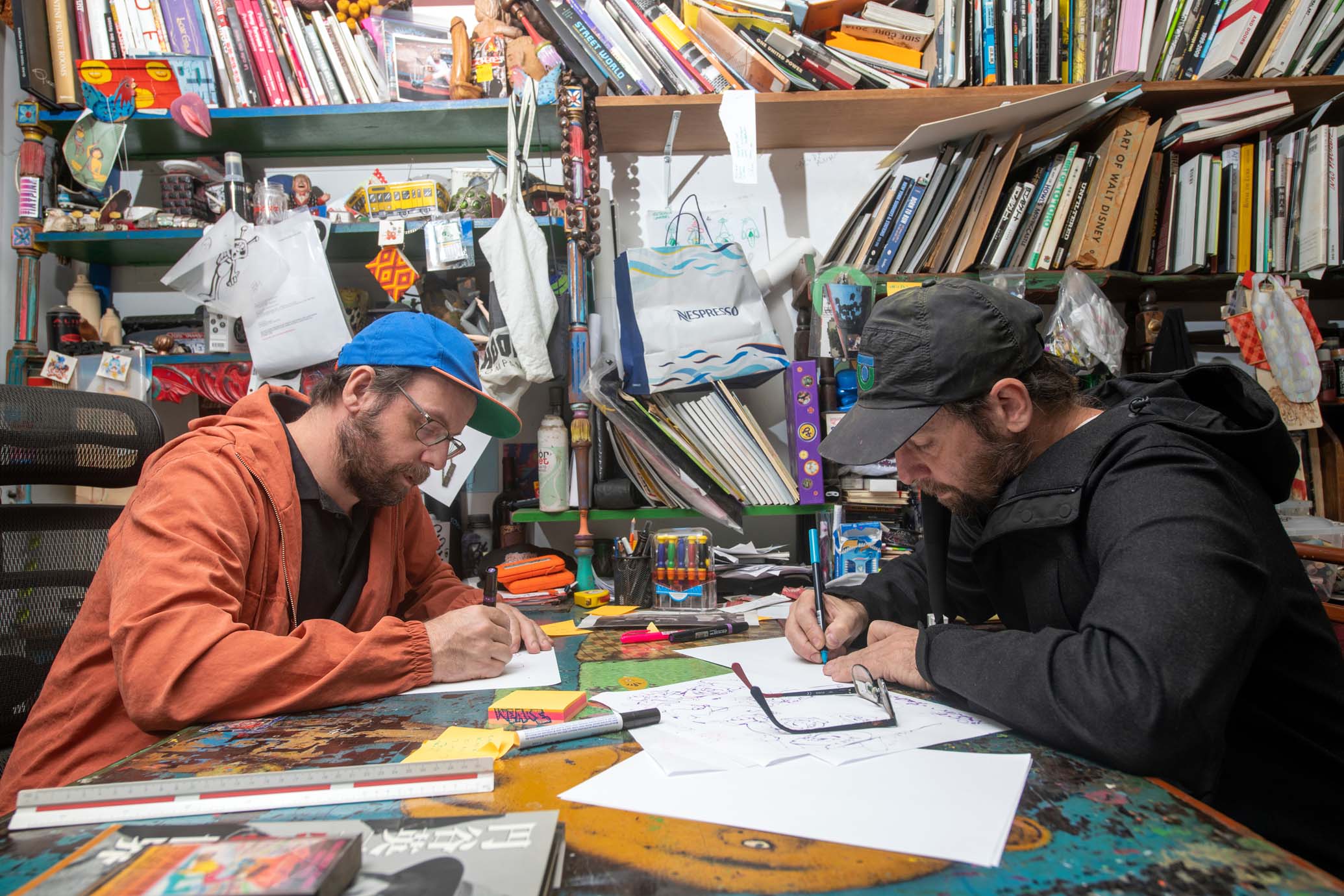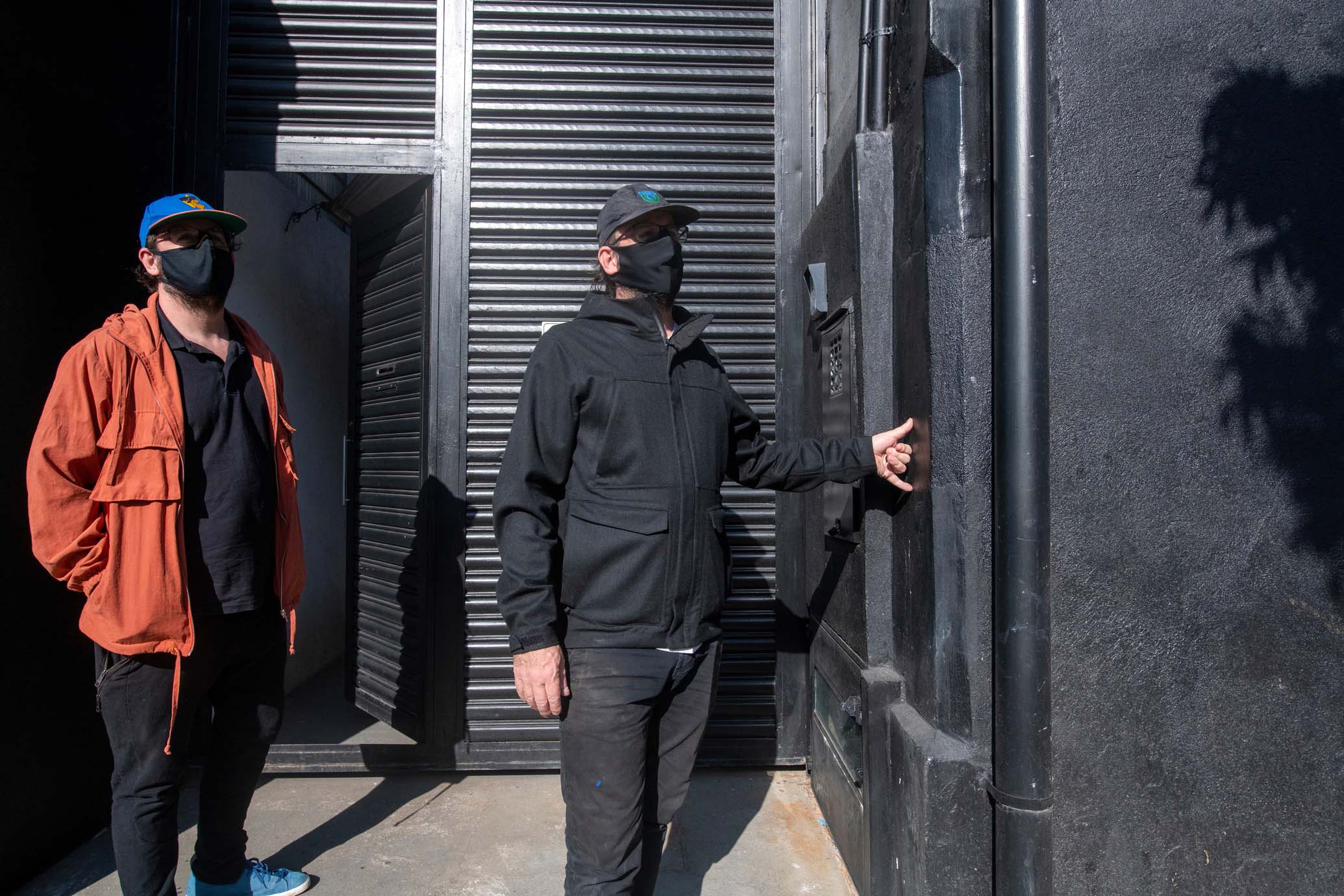
Brazilian twins, Otavio and Gustavo Pandolfo, who work under the joint moniker OSGEMEOS, have been mainstays in the graffiti game for nearly forty years. They got started young, growing up in the Cambuci district of São Paulo, where they were part of the first generation of Brazilian Hip Hop. Since their early days breakdancing, throwing up tags and doodling in their childhood room, the brothers have become internationally known for their whimsical style of figurative painting that depicts a variety of yellow-hued street characters climbing through dreamlike scenarios. Their subjects have a signature deadpan expression, with small squinting eyes and tight-lipped mouths caught between a grin and a grimace. Inspired by everything from ancient folklore to current events, the artists rummage for modern truths, painting otherworldly figures who may hover on spindly legs, but face the viewer with a defiant look.
As active graffiti writers as well as full-time studio artists, they have inhabited a grey area when it comes to official respect for their work; just three years ago, a large freeway mural they created in São Paulo was buffed over by an “urban beautification” cleaning crew. But they will soon enjoy a major retrospective in their hometown, at the Pinacoteca do Estado de São Paulo, a show that will survey their life’s work and, in some ways, vindicate their outlaw status. Titled “Secrets” or “Segredos,” the exhibition will include several rooms of large-scale installations, paintings, sculptures and sound pieces, as well as archival materials such as sketches and other historical objects. They chose this title because “we are going to show things we never showed to anyone before,” says Otavio—“well, some of them, but not all,” Gustavo interjects, smiling. I spoke with the artists via video from their studio brimming with pens and notebooks, where they were leafing through old books with an air of nostalgia.

The pandemic has given everything a new context, and the artists’ process of sorting through their archive and reflecting on their trajectory has given them some insight into the future. “Brazil has changed a lot,” says Otavio, “but it also looks like it never changed. We still see a lot of hungry people, kids in the streets.” The installation of the Pinacoteca show ground to a halt due to the COVID-19 crisis and, meanwhile, the artists have been involved with mutual aid efforts as Brazil experiences one of the worst outbreaks of the virus. The museum’s reopening date remains unknown.
The artists have seen the government go through many changes, from the end of the military dictatorship in 1985 to the current far-right presidency, but graffiti has remained a constant. When it comes to graffiti in Brazil, Otavio explains, “the laws are made by the police who catch you. They can put you in prison right away or they can let you go. But we keep doing this—it doesn’t matter if they change the government or if they change the laws, we are going to continue to do it. We need that to talk to people. So we will find a way.”
When they first opened their archives to prepare for the retrospective, they reconnected to the power that art and graffiti had for them as kids. They found drawings on crumbling paper, a huge volume of sketches, even toys they made to play with and clothing they had painted. They recall listening to Grandmaster Flash with their friends, as well as opera and classical music with their grandfather and Led Zeppelin and heavy rock with their brother—a patchwork of different influences sparked their creativity from a young age. They hadn’t seen many of the items in their archive in decades and when they pulled everything out and organized it, they realized that “we moved through more than thirty or thirty-five different styles,” says Gustavo. “We produce a lot. If you are drawing something now, you are really going to see it in a few days or years, to realize connections, because it’s too deep inside,” he reflects. “We created a world,” one that continues to be elaborated in their works on canvas, through large-scale installations and in street paintings—sanctioned and unsanctioned.
A fateful visit from Barry McGee in 1993 changed their relationship to their creative work. At the time, they had little contact with other subcultures or ways of living as artists. McGee was the first non-Brazilian they met, and he introduced them to American graffiti handstyles, as well as the idea of developing a serious studio practice. Otavio remembers wondering, “how did he come from California to do an exhibition in Brazil, and they paid him to come and stay for six months? We thought it was impossible to do anything here because the market was very closed. He showed us the possibilities.” Since then, they have found a tremendous market for their works on canvas, which often sell for six figures, as well as the support of a massive international fan base. They hold the unusual position of having mainstream influence as well as elite credibility in the art world. Now that OSGEMEOS have made the big time, they are excited to see a new generation of artists in Brazil taking their own work seriously, too. “We opened the door and now it’s open,” says Otavio. “A lot of people have a lot of talent and it’s time to show it.”

Yet despite their many accolades, including recent solo shows at the Frist Art Museum in Nashville, the Hamburger Bahnhof in Berlin, the Mattress Factory in Pittsburgh and the Pirelli HangarBicocca in Milan, they keep a humble outlook, maintaining their street writing and reverence for authentic graffiti culture. “Situations that belong to the street,” says Gustavo, “you don’t see inside private places.” When creating work for a gallery space, he explains that “the universe is the same, but the spirit is different.” Otavio continues, “tags are talking about the time we have now. Graffiti is for people who like it and people who don’t like it,” he says mischievously. “But we try to communicate everywhere, to be strong, especially now. We need to be more strong and create more art.” With eyes downcast, he says sincerely, “we really believe that art has the power to change things.”
OSGEMEOS will present a new body of works on canvas this fall at Lehmann Maupin in New York. With this exhibition, the artists further cement their status not as “street artists” but “artist artists” who use vibrant geometric patterns to create optical effects and delicately rendered characters to conjure surreal worlds. While these paintings hold their own in Chelsea, I think the artists would be just as happy if you visit their show as if you look closely at the tags on cargo vans and storefront grates, scratched into bus windows and sprayed in dark subway tunnels. Their reason is simple yet potent: “Someone is speaking there. There are a lot of poems in the street. Stop to look,” Otavio says. Even while their work has evolved over the decades, one truth they hold has remained clear: “we are here, and we are not alone.”
OSGEMEOS’s exhibition “Portal” is on view at Lehmann Maupin in New York through October 31.










 in your life?
in your life?

